Your feedback is important to us
Please provide any feedback you have. Thank you!
Thank you!
Your feedback has been submitted.
 See if your state is part of the Smarter Balanced Assessment Consortium
See if your state is part of the Smarter Balanced Assessment Consortium
Please provide any feedback you have. Thank you!
Your feedback has been submitted.

See what skills are tested, understand your child's scores, and get ideas for how you can help at home.
The Reading Literature standard refers to reading fiction, plays, and poetry. In fifth grade, texts are suddenly getting a lot more complicated. To help fifth graders understand the themes in stories, they’re taught to look closely at how characters respond to events. For example, in A Wrinkle in Time, the main character Meg uses love to help her rescue her brother from a giant monster brain. Students should be able to realize that this plot point — Meg overcomes the monster — is a clue to the theme about the power of love.
Watch how fifth graders show their understanding of what they read.

During class discussions and in writing, fifth graders are expected to quote directly from stories, poems, and plays to support their ideas about what they’ve read.
They also pay attention to how illustrations and multimedia can influence the meaning and how the narrator’s point of view (first person/third person) affects how the story is told.
A fifth grader who is struggling to understand the main idea of a text needs a lot of reading practice with modern classics like Holes or Because of Winn-Dixie. Fifth graders should be reading at least 30 minutes a day. Children who are behind need to spend extra time reading at and above their level in preparation for sixth grade – a year which brings new challenges, academically as well as emotionally. Check out these books for your fifth grader that are both wonderful stories and count as “complex texts” under the new standards.
Want to know one of the most powerful ways to inspire your child to read? Read for your own pleasure! Seeing you read the morning newspaper, a book before bed, or a favorite blog goes a long way toward showing your child how reading can enrich a person’s life. Establish a regular 30-minute (or more) family reading time (daily is best, but even weekly will send the right message). Everyone in the family has a book, magazine, or tablet to read. When the time ends, ask everyone to share what they learned.
The best way to help your child understand what he reads is to talk about it. Ask your child:
Fifth graders need to be good at identifying the main point and finding evidence in what they read. Ask your child’s teacher about these skills. Is your child quick to identify the main point? When your child points to evidence, is it the strongest example, or more of an extra detail? Knowing your child’s strengths and weaknesses will help you figure out the best way to help him build these skills.
The Reading Information standard refers to reading all kinds of nonfiction. Kids are being asked to read more nonfiction ever since educators realized that many students were graduating from high school unprepared for college and careers precisely because they couldn’t read complex nonfiction.
In fifth grade, kids continue to use the skills they’ve learned in previous grades, but now more is demanded of them in some skill areas. For example, they’re asked to find more than one main idea in a text and cite the evidence supporting each.
They’re also expected to compare ideas, events, and individuals described in two different informational texts — such as a chapter from the Little House on the Prairie series and a history article about the Chippewa tribe that lived near Laura Ingalls Wilder’s family.
When reading a historical, scientific, or technical text, fifth graders should be able to explain how individuals, events, or ideas interact. For example, in an article about a mysterious disease that is killing starfish, students should connect the threat to the starfish population to the survival of the larger fish that are losing an important food source, and to the effort in Congress to fund the study of this unknown virus. Students are expected to quote directly from the article when making these connections.
Watch this video about how fifth graders build knowledge through reading.

A fifth grader struggling to understand the main idea of a text needs a lot of practice reading articles from magazines or online sources like Newsela. Fifth graders should be reading at least 30 minutes a day. Children who are behind need to spend extra time reading at and above their level in preparation for sixth grade, which can be a difficult year. Find several challenging nonfiction books for your fifth grader here.
Want to know one of the most powerful ways to inspire your child to read? Read for your own pleasure! Seeing you read the morning newspaper, a history book before bed, or a favorite science magazine goes a long way toward showing your child how reading can enrich a person’s life. Establish a regular 30-minute (or more) family reading time (daily is best, but weekly still sends the right message). Everyone in the family has a book, magazine, or tablet to read. When the time ends, ask everyone to share what they learned.
The best way to help your child understand what he reads is to talk about it. Ask your child:
Ask your child’s teacher what areas of nonfiction reading need most support. Ask for books to recommend and resources for learning new skills.
Fifth graders encounter many new words as they read increasingly challenging fiction and nonfiction texts. Some are general academic words, or words that are used often, in many subjects, but can be hard to define, such as navigate, heroic, or scarce. They also come across words that are specific to a particular subject, known as content-specific words, like treaties, colonial, and ratification in history.
Watch how a teacher guides a fifth grader through the process of figuring out new words.

Students should rely on three key strategies to determine the meaning of new words:
Kids continue to work with figurative language, such as metaphors (a comparison of two unlike things: life is a highway) and similes (a comparison using like or as: brave as a lion).
Figurative language can be especially challenging for English learners. First they need to learn the literal meaning of the words, then they can try interpreting symbolism in phrases. (Imagine trying to understand the elephant in the room if you were learning English!)
Your child should learn about 2,000 new words in fifth grade — and most of these new words should come from reading. When your fifth grader encounters a new word, he should try to figure out its meaning. Here’s how:
It’s important for fifth graders to build their academic vocabulary. These are words that are used often, in many subjects, but can be hard to define, such as approximate, frequent, and escalate. Academic vocabulary is also more precise, like saying announced, claimed, or concluded instead of said. Check out this list for more academic vocabulary words to use with your fifth grader. Sign up for GreatWords, our free vocabulary-boosting text message program, to get daily text messages with 5th grade academic vocabulary words. To get started, text WORDS to 88769. (See terms and conditions.)
To increase your fifth grader’s academic vocabulary, introduce a new word every day. Tell your child what it means and have him use it in a sentence or find a synonym or antonym. Try to weave the new words into conversations with your child. Help him start a daily word journal where he creates a page for each day’s new word. He can write a sentence or draw a picture to illustrate his sentence.
To understand figurative language, like metaphors and similes. As you read books and watch TV together, point out examples of figurative language, like happy as a clam. As your child learns a new phrase, like strong as an ox, ask her to use it in a sentence. See how many new metaphors and similes you can find in one week.
Here are four teacher-recommended books that use boatloads of figurative language:
The Giving Tree by Shel Silverstein
The Phantom Tollbooth by Norton Juster
Fair Weather by Richard Peck
Snicker of Magic by Natalie Lloyd
Kids need to be steadily growing their knowledge about the world with every new article, story, and website they read. A strong vocabulary is a huge predictor of academic success because it helps children understand what they read and lets them express their ideas. Ask your child’s teacher what you can do at home to help expand his word knowledge.
Fifth graders should be paying close attention to how they structure their writing. Whether telling a story (narrative writing), writing a report (informational writing), or convincing the reader of their point of view (persuasive writing), fifth graders should clearly introduce their topic and present related information in the form of a few clear, well thought-out paragraphs.
See an example of fifth grade writing.
In narrative writing, fifth graders should learn how to organize an interesting sequence of events and use dialogue, description, and pacing to catch and maintain the reader’s interest.
When writing persuasive and informational pieces, students should draw on facts, definitions, and quotes from their reading to thoroughly develop their topic or opinion. At this age, students should use advanced linking words (for example, in contrast, especially) to form compound and complex sentences that convey their points. To wrap it up, your child should have a well-reasoned conclusion.
Fifth graders should also be able to revise their own work to catch errors and improve how their writing flows.
Find out what your child enjoys reading (comics, funny poems, letters, stories, etc.) and ask her to try writing in that format. Remember to celebrate your child’s ideas.
What’s missing in your child’s writing? Your child’s teacher can tell you, but it’s better to ask her to show you. Bring in a couple of your child’s writing samples and ask the teacher to point out what’s strong and where your child’s writing needs work. The teacher may have other samples to share with you, too. Using writing samples can help your child’s teacher explain things more clearly.
Fifth graders should be able to explain that conjunctions like and and if are used to connect words, phrases, or clauses; that prepositions like above and during describe when or where something happens; and that interjections like boo and whoa express emotions.
When revising their writing, fifth graders should expand, combine, or shorten sentences to better explain and maintain the reader’s interest.
Fifth graders also begin to pay attention to differences in dialects (Jamaican vs. U.S. English) and speaking style (baby talk vs. academic speech) and analyze how they are used in writing.
How is the grammar and punctuation in your child’s writing? Your child’s teacher may have a better sense than you do. Ask the teacher to point out your child’s strengths and areas where his writing needs work. If necessary, develop goals to improve these skills.
Major Content is true to its name. These are the big concepts in fifth grade. If your child is behind in any of these skills, seek support (and check out our How to help section). The PARCC test will focus on these concepts, and your child’s teacher should spend a lot of class time helping your child nail these skills.
Fifth graders get really good at finding common denominators (the bottom number) so they can add and subtract fractions with different denominators (e.g., 3⁄25 – 1⁄5) and mixed numbers (e.g., 3⁄15 + 4 2⁄5).
Watch how a fifth grader finds the common denominators in fractions.

Students learn how to multiply a fraction by a whole number and how to multiply a fraction by a fraction.
When it comes to multiplying fractions, it helps if kids understand three rules of thumb (and why they are true):
Watch fifth graders show their understanding of these multiplication rules.

This year, kids take the (big!) next step with fractions: dividing whole numbers by unit fractions (1⁄2, 1⁄3, 1⁄4, 1⁄6, etc.) — and the reverse: dividing unit fractions by whole numbers. Dividing with fractions is tricky. For example, dividing 8 by 1⁄2 is really asking how many times 1⁄2 can fit into 8. The answer is 16, which is larger than 8 or 1⁄2. Dividing 1⁄2 by 8 asks how to break down 1⁄2 into 8 smaller fractions. The answer is 1⁄16, which is smaller than 1⁄2 or 8.
When it comes to working with decimals, fifth graders are expected to:
At this age, kids learn to think about the place value with a new understanding of base 10, which means understanding that the value of the number 4 can be bigger or smaller based on whether it’s in the ones place, the tens place, or the hundreds place. (For example, check out this table.)
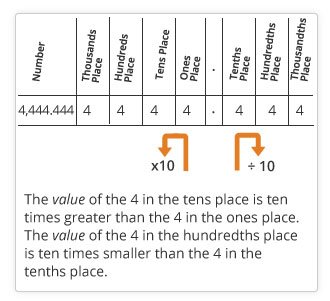
Another way students practice working with place value is knowing how to express a large number like 345.678 in expanded form, like this: (3 x 100) + (4 x 10) + (5 x 1) + (6 x 1⁄10) + (7 x 1⁄100) +(8 x 1⁄1000).
Fifth graders delve deeper into geometry by learning how to measure the volume of a right rectangular prism (a 3-D shape with six rectangular sides). It’s a new way for kids to apply their multiplication skills, because they multiply the shape’s width (w) by its height (h) by its length (l) to find the volume (v), because v = w x h x l.
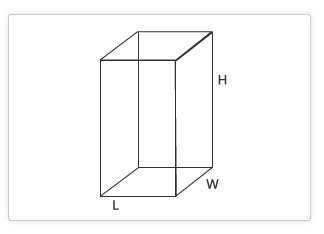
Fifth graders use their knowledge of equivalent fractions (e.g., 1⁄2 = 2⁄4 = 3⁄6 = 4⁄8, etc.) to add and subtract fractions that have different denominators (the bottom numbers).
Sample problem 1: Finding a common denominator and adding fractions
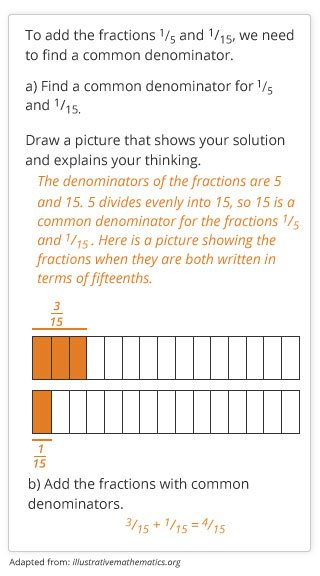
Fifth graders learn to multiply a fraction, like 1⁄3, times a mixed number, like 2 1⁄4.
Sample problem 2: Multiplying fractions and mixed numbers
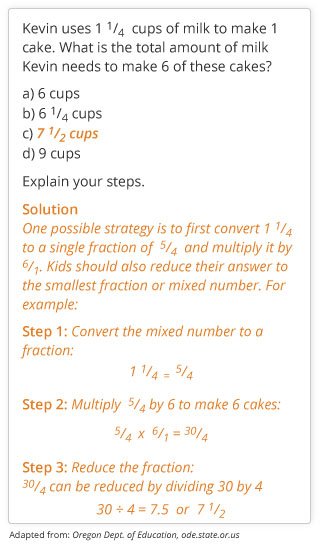
Fifth graders are expected to become proficient at dividing whole numbers by fractions and vice versa.
Sample problem 3: Dividing whole numbers by unit fractions (and vice versa)
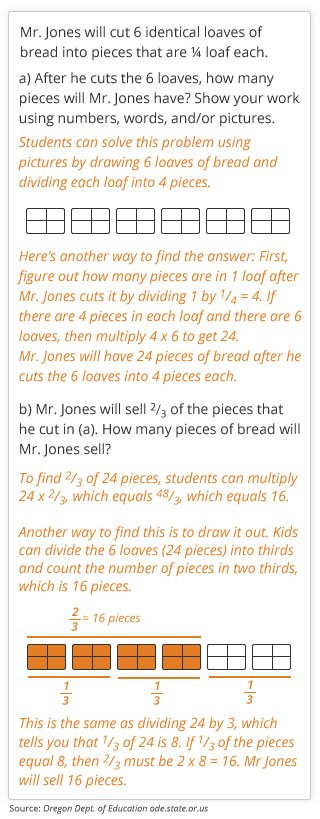
Fifth graders need to understand place value for decimals to the thousandths place. Students are taught to make sense of place value by breaking down numbers this way:
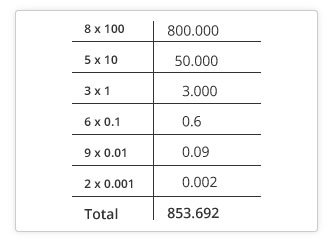
Sample problem 4: Place value
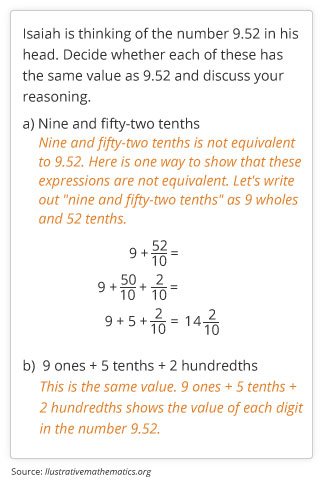
Students also need to understand place value in order to compare decimals. This number line question shows what students may be asked to do on a test.
Sample problem 5: Comparing decimals

In fifth grade, students learn to calculate the volume of right rectangular prisms by using this formula:
(v) volume = (l) length x (h) height x (w) width

For the following problem, students have to imagine that they’re filling each rectangular prism to the top with 1-centimeter (cm) cubes. Think of it as a rectangular-shaped Rubik’s Cube.
Sample problem 6: Finding the volume of right rectangular prisms
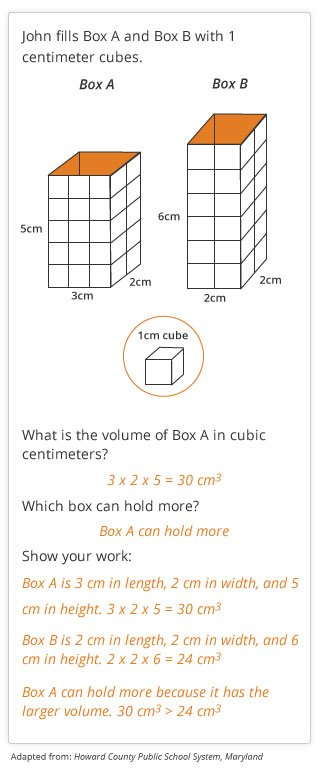
No one brags about being a poor reader, so why is it acceptable for people to brag about being bad at math? It’s a question asked by University of Chicago Professor Sian L. Beilock. She’s right! If we want our children to have a positive attitude about math, then we need to talk about math as an enjoyable skill that we can all learn.
Fifth grade math builds on fourth grade math, which builds on third grade math, and so on. At some point, your child may have hit a snag — and that’s okay. To help, ask the teacher when your child started having trouble. What skill were they learning then? Ask what the teacher is doing about it, and how you can help your child boost that particular skill (or skills) at home.

If Additional and Supporting Content sounds a wee bit less important than Major Content, trust your instincts: you’re right. Teachers may spend less time on these skills (and this content is given less weight on the PARCC test). But these additional skills are building blocks — they’re a good way to tell whether your child is set up for success in sixth grade math.
To solve real-world problems that involve measurement, fifth graders have to convert different-sized numbers in the same measurement system, like millimeters, centimeters, and meters. A problem may ask kids to find the perimeter of a rectangular room in meters but give the lengths in centimeters. It’s a supplemental skill that shows off your child’s ability to add as well as his ability to find equivalent values.
Fifth grade students start writing simple equations that describe a numerical relationship. For example, students may be asked to write an expression for add 8 and 7, and then multiply the sum by 2, which would be 2 x (8 + 7). This sets kids up for sixth grade, when students work more with equations.
Teachers spend some time in fifth grade showing students how to recognize patterns and identify relationships between terms and values by creating line plots (a type of number line) and graphs. The data from these graphs is then used in multi-part word problems. For example, the graph below shows the relationship between people knocking on a door and the dog barking. The accompanying word problem would ask students to calculate the ratio of barks to knocks.
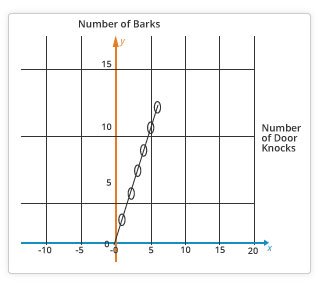
An additional skill in fifth grade is classifying two-dimensional shapes into categories based on their properties, (e.g., triangles with right angles). It sets kids up for success down the line, when geometry becomes a major skill.
When children feel anxious about math, they tend to have lower grades. They’re also less likely to take the math classes they need to get into college. Help your child avoid this slippery slope. How? By presenting a positive attitude toward math. It works!
Maybe you cringe at the idea of the teacher asking you to come in after school for a “talk.” Turn the situation around by being proactive. Ask the teacher for an after school meeting to discuss how to help your child overcome math challenges. Start by finding out when she started having difficulty. Was there a specific topic that set her back, such as working with shapes? The teacher has resources, so ask for activities you can try at home, at the store, or in the car to get your child back on track.

In fifth grade, students are expected to do more than solve problems — they’re expected to defend their work by explaining how they solved a problem and why they chose the operations they used. Often, this involves creating a logical and convincing argument using words, but kids are also encouraged to use pictures, charts, graphs, and other models to help explain their thinking.
Kids learn to flip the process around to critique their classmates’ work and explain why they think an answer is correct or incorrect. This process requires students to apply all the math skills they’ve learned to analyze a problem, identify the steps necessary to solve it, and be able to explain the mathematical reasoning behind their approach.
Watch how fifth graders explain whether they agree or disagree with a classmate’s solutions and why.
If students find any mistakes in their own work or a classmate’s work — for example, they did the order of operations wrong or the place value is off — they are expected to identify the problem and suggest ways to correct it.
Oh yeah? Prove it! Kids say that to each other all the time. One way fifth graders have to prove things (at least in math) is by creating charts, tables, graphs, and other visuals that contain the important data, are organized to show how the numbers or quantities relate to each other, and illustrate how they worked out a problem.
Sample problem 1: Constructing clear and logical arguments to support their work
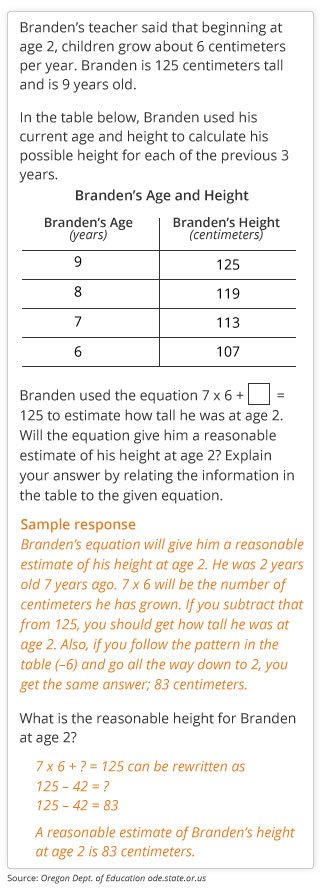
Students are also expected to learn from each other under the new standards. By critiquing each other’s work in a safe and respectful manner, fifth graders may find that they’ve made similar mistakes. This process also helps them learn how to construct clear and logical arguments to support correct answers and explain the problems that lead to incorrect answers.
Sample problem 2: Critiquing a classmate’s problem solving
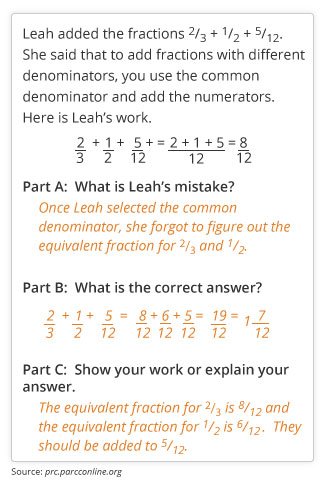
Attitude is a little thing that makes a big difference. That quote by Winston Churchill is great advice for all things in life, especially learning math! This is doubly true when it comes to Mathematical Reasoning, since it involves kids using their communication skills (and diplomacy) to explain their thinking about what is right (or wrong) in a problem.
Learning is complicated. Your child may be great at memorizing things, like which step goes first, but struggle to communicate why she’s following those steps. See if the teacher has ideas about how you can help your child practice communicating her thoughts so she’ll be able to share her reasoning in math class.

Modeling links math to everyday problems. Kids learn to analyze situations so they fully understand them and make better decisions. A model can be a few things, including making a table or graph, drawing a picture, or writing an equation. Models can be very simple, such as writing the cost of a unit price (e.g., $1.00/apple). Number lines are often used as models, too.
By fifth grade, students should be able to read a word problem and develop a plan to solve it based on their experience of what works in similar situations and whether that knowledge is likely to apply to this problem.
Students are expected to use the different strategies they’ve learned to analyze the problem, determine the steps to take, and find the solution.
When a model isn’t working, students are expected to fix it and try again. This requires some trial and error, which boosts problem-solving skills and perseverance.
Fifth graders are expected to evaluate answers — their own and other students’. For example, kids may be asked to evaluate whether or not an answer is reasonable based on a model they’re given.
Think about how you use math in your life. Probably not a day goes by that you don’t compute, calculate, or count. Which gas station is cheaper if one charges less per gallon than another but charges you a fee to use your bank card? If there are seven of us for dinner and we’ll each eat 1⁄3 pound of chicken, how many pounds do I need to buy? Knowing how to think through complex problems is an important life skill. By the end of fifth grade, students should be able to analyze situations that arise in their lives and figure out the best strategy for finding the solution. That may involve writing an equation or creating a diagram, table, or chart that shows the relationship between the most important quantities.
By the end of fifth grade, students should be able to analyze a real-world problem, determine the most important quantities, and figure out how to represent those quantities through an equation, chart, graph, diagram, or other model.
Sample problem 1: Using models to solve real-world problems
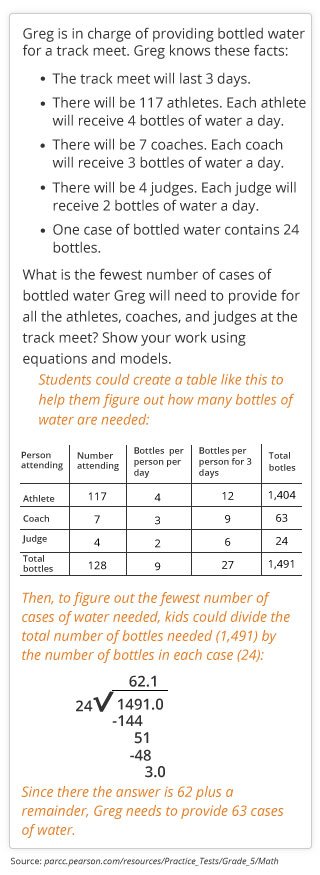
Sample problem 2: Using a number line as a model
This problem shows how students can use a number line to understand a real-world problem.

You know the saying: children learn by example. Even if you’re one of the people who suffer from math anxiety, it’s best for your child to keep that dread under wraps. Instead, try to embrace math and show your child how useful it is in everyday life.
We tell our children to ask their teacher for help; we can (and should) do it, too. Set up a meeting with your child’s teacher and ask for ideas to help your child develop her problem-solving abilities.

GreatKids created this guide to help you understand your child's state test scores and to support your child's learning all year long. We worked with SBAC and leading teachers in every grade to break down what your child needs to know and exactly how you can help